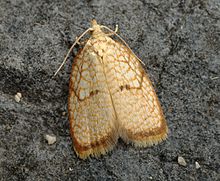Acleris forsskaleana
| Acleris forsskaleana | |
|---|---|

| |
| Scientific classification | |
| Domain: | Eukaryota |
| Kingdom: | Animalia |
| Phylum: | Arthropoda |
| Class: | Insecta |
| Order: | Lepidoptera |
| Family: | Tortricidae |
| Genus: | Acleris |
| Species: | A. forsskaleana |
| Binomial name | |
| Acleris forsskaleana | |
| Synonyms | |
| |
Acleris forsskaleana, the maple leaftier moth, is a moth of the family Tortricidae. It is found in Europe and North America[1] in woodlands and gardens.
The wingspan is 12–17 mm. The ground colour of the forewings is yellowish underlying a reticulated darker pattern and a greyish suffusion across the disc.It has a dark, V-shaped transverse line and dark outer edge, otherwise numerous, narrow, brown transverse lines. Together with the brownish wing veins, these form the net pattern. The larva is yellowish, partially transparent so that the dark greenish intestines shine through. The head capsule is barely darker than the rest of the larva. [2] Julius von Kennel provides a full description. [3] Meyrick -Forewings suboblong, 7 to apex; pale yellowish, sharply reticulated with ferruginous orange, somewhat mixed with dark fuscous; a dark fuscous oblique stria from middle of costa, meeting a variable sometimes obsolete fuscous dorsal blotch, containing two small black scale tufts; a dark fuscous terminal streak. Hindwings whitishyellowish, more or less fuscous-tinged posteriorly.Larva pale yellow; head and plate of 2 greenish-tinged[4]
The moth flies from June to September from dusk onwards.
The main food plants in Europe are field maple (Acer campestre) and sycamore (A. pseudoplatanus); the larvae can also be found on Norway maple (A. platanoides).
The name honours Peter Forsskål.
References
- ^ Opler, Paul A.; Kelly Lotts; Thomas Naberhaus. "Acleris forsskaleana". Butterflies and Moths of North America. Retrieved 12 February 2014.
- ^ Bradley, J.D.; Tremewan, W.G.; Smith, A. 1973 British Tortricoid Moths [Vols 1+2] Ray Society 1973-1979, London.
- ^ Julius von Kennel, 1921, The Palaearktischen Tortriciden, eine monographische Darstellung. Stuttgart: E. Schweizerbart'sche Verlagsbuchhandlung. 742 pp. - Palaearctic Tortricidae, a monograph.pdf at Zobodat 170
 This article incorporates text from this source, which is in the public domain.
This article incorporates text from this source, which is in the public domain.
- ^ Meyrick, E., 1895 A Handbook of British Lepidoptera MacMillan, London pdf
 This article incorporates text from this source, which is in the public domain. Keys and description
This article incorporates text from this source, which is in the public domain. Keys and description
External links
 Media related to Acleris forsskaleana at Wikimedia Commons
Media related to Acleris forsskaleana at Wikimedia Commons- waarneming.nl (in Dutch).
- Lepidoptera of Belgium
- Acleris forsskaleana at UKMoths
